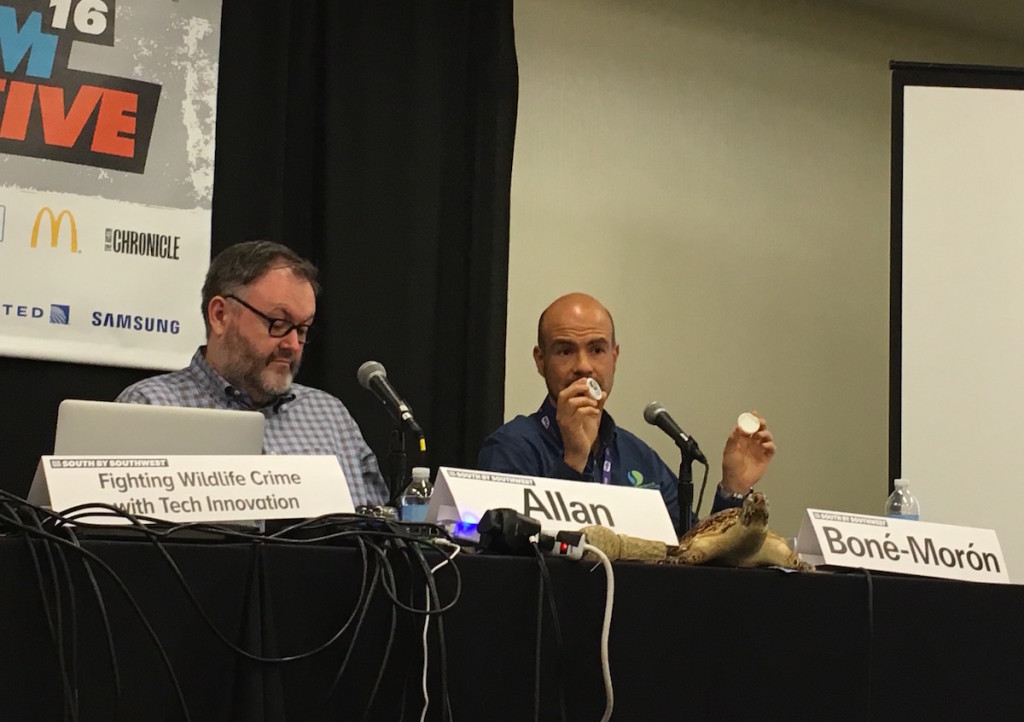Innovative Technology Fights Wildlife Crime
March 24, 2016
The illegal wildlife trade is a $20B black market based on corruption—a global crisis that pops up in news headlines with heartbreaking stories of endangered species being poached and confiscated at customs. These activities are driving species of elephants, rhinos, tigers, pangolins, turtles, parrots and others towards extinction. Rhino poaching has increased by 9,000% since 2007; 100,000 elephants were killed in just three years; and the tiger population has decreased by 40 percent in the last decade. Our partners at the U.S. Agency for International Development’s Wildlife Crime Tech Challenge (WCTC), a partnership with National Geographic, Smithsonian, and TRAFFIC, is finding solutions to this global crisis through innovative science and technology.
Corruption is the key enabler of wildlife trafficking, creating illegal supply chains and fueling criminal networks that devastate vulnerable species and harm livelihoods. With prices for illegal products becoming higher and trade becoming more dangerous on the black market, individuals in positions of power become more inclined to accept bribes or help organize illegal trade networks. In addition to the toll on wildlife, over 1,000 rangers have lost their lives protecting wildlife in the past decade.
The WCTC believes that by harnessing the power of science and technology, the global community can create innovative solutions to four key issues related to wildlife trafficking:
- Tackle corruption
- Reduce consumer demand
- Strengthen forensic evidence
- Detect transit routes
Three hundred innovators from 52 countries applied to the Wildlife Crime Tech Challenge call for solutions, and 16 innovators have been short-listed to launch their ideas with $10,000 each and technical assistance. Now it’s up to them to compete for a grand prize of $500,000 to scale their projects.
One of the 16 winners, Paso Pacifico, is competing with a project to detect and monitor regional transit routes of poachers dealing in endangered sea turtle eggs. The organization and its partners will create, plant and track artificial sea turtle eggs containing covert GSM-GPS tracking devices and forensic markers. These false eggs will be planted in nests at high risk of poaching—a common occurrence on Central American beaches that threatens Leatherback, Hawksbill, Green and Olive Ridley sea turtles. By tracking these eggs, Paso Pacifico hopes to reveal trafficking routes to authorities. Partners in this project include: Wayra-Mexico and NFCGroup to supervise development of tracking devices; Dr. David Bothman of UC Santa Barbara to provide engineering expertise; Goodnight & Co to help create the artificial eggshell; and Nicaragua’s Ministry of the Environment and Natural Resources, the Mexican Center of the Turtle, the Eastern Pacific Hawksbill Initiative, Costa Rica’s Guanacaste Conservation Area, and the Turtle Island Restoration Network to provide additional support. Read more on TakePart.com.

Another ocean-related winner, For the Fishes, is developing a mobile app to reduce consumer demand for unsustainably caught aquarium species. Aimed at raising awareness, their Tank Watch app will allow consumers to distinguish popular aquarium species bred in captivity (i.e. coral reef-friendly fish) from those caught in the wild through harmful practices like cyanide fishing, which is illegal, toxic, and weakens and kills both target and non-target fish, corals and other wildlife. Up to 70 percent of fish sold through the marine aquarium trade are caught with this harmful method, and 98 percent of saltwater aquarium species cannot yet be bred in captivity. For the Fishes is partnering with the U.S. Humane Society, Humane Society International and Aysling.
WCTC introduced the winners at this year’s SXSW conference in Austin, TX. “This was a fantastic opportunity to present the Wildlife Crime Tech Challenge, our Prize Winners and the issue of wildlife trafficking to a new audience,” said Scott Hajost, WCTC Chief of Party, “and I was thrilled by the positive response we received.” During its session, the WCTC team tracked down three “poachers” hiding in the room to demonstrate Paso Pacifico’s prize-winning innovation to reveal sea turtle egg trafficking routes using trackable artificial eggs. For the purposes of the demo, these eggs were rigged to sound an alarm and hidden around the room. Amidst lots of laughter, a surprised audience followed the sound to find the three eggs, and some inadvertent poachers!
Mission Blue founder and National Geographic Society Explorer-in-Residence, Sylvia Earle, National Geographic journalist Bryan Christy, and USAID Forestry & Biodiversity Office Director, Cynthia Gill share how the U.S. Agency for International Development works to reduce demand for wildlife products and develop innovative solutions to combat wildlife trafficking in the short film below. To learn more about USAID’s Wildlife Crime Tech Challenge, visit https://wildlifecrimetech.org.








ANIMALS ARE MY FRIENDS AND I AM HERE TO HELP THEM BE STONG AND FIGHT THE WICKED
Fantastic!